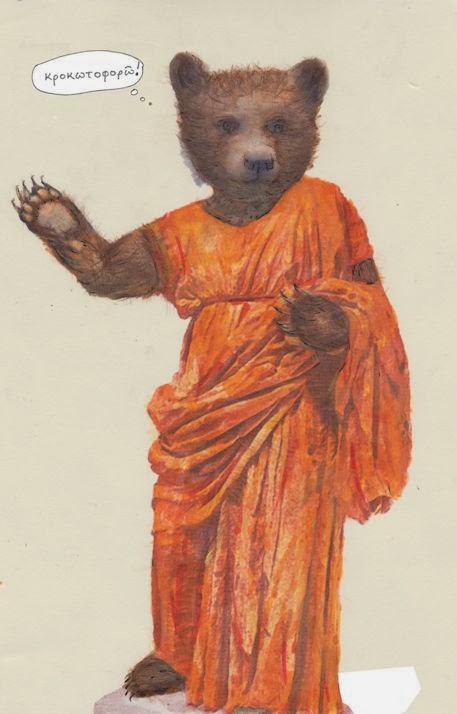
I was wearing a knife in my backWho are these people, and why are they doing these things? I don't know. But these are the people I know of who wear or have worn saffron robes.
You were wearing a saffron robe
Then you set yourself on fire
This situation's burning out of control
to dye clothes a bright yellow-orange color.
- Some Buddhists monks.
- Hindus who have renounced the world. According to Wikipedia, "Symbolically, a sannyasi casts his physical body into fire by wearing saffron robes when entering this phase, signifying purification of body through fire thus freeing the soul while the body is still alive."
- Students at the School of Metaphysics, at their graduation ceremony. (Or so one of them told me.)
- Little girls in classical Greece, while doing a dance called the arkteuein ("acting like a bear") during a rite of passage at the sanctuary of Artemis at Brauron.1, *
- Priestesses of the Minoan goddess on the island of Thera, before it exploded.2 The frescoes there also show girls harvesting crocuses and presenting them to the goddess, which suggests that it's considered sacred to the goddess. Other frescoes show robe presentation ceremonies.
- Eos, the goddess of Dawn, according to Homer: "Dawn in her saffron robe came spreading light on all the world..."3
- Hekate, according to an Orphic hymn: "Celestial, Chthonian, and Marine One, Lady of the Saffron Robe."4


References
1 Rockwell, David B. Giving Voice to Bear: North American Indian Myths, Rituals, and Images of the Bear . Lanham, MD: Roberts Rinehart :
Distributed by National Book Network, 2003: 168.
. Lanham, MD: Roberts Rinehart :
Distributed by National Book Network, 2003: 168.
2 Castleden, Rodney. Atlantis Destroyed . New York: Routledge, 1998: 67.
. New York: Routledge, 1998: 67.
3 Homer, Fitzgerald Robert. The Iliad. Garden City, N.Y.: Anchor
Press/Doubleday, 1974: 175.
Garden City, N.Y.: Anchor
Press/Doubleday, 1974: 175.
4 “Orphic Hymn to Hekate.” Accessed January 29, 2014. http://www.hermeticfellowship.org/OrphicHymnHekate.html.
See also...
After writing this, I found these two interesting, informative series of articles about saffron.
Saffron Mother, by Elatia Harris, at 3 Quarks Daily. An extremely well-written series of three articles; the first part is about the use of saffron on Thera and includes pictures of the frescoes that I mentioned.
Ancient Cultic Associations of Saffron Crocus, by Paghat. An exploration of saffron symbolism in mythology. Among other things, it shows pictures of Hindu goddesses wearing saffron-colored clothing. Her site has articles about the lore of many other plants as well.